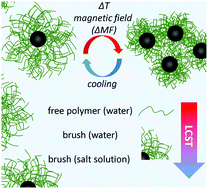Controlled aggregation and cell uptake of thermoresponsive polyoxazoline-grafted superparamagnetic iron oxide nanoparticles†
Abstract
Hydrophilic polymer-coated iron oxide nanoparticles are potential materials for a plethora of applications in the biotechnological field. Typical such polymers, e.g. dextran or poly(ethylene glycol), lack the ability to tailor the biological response to an environmental trigger, while common responsive polymers such as poly(N-isopropylacrylamide) or poly(acrylic acid) are not suitable for biomedical applications. We present the synthesis and characterization of superparamagnetic iron oxide nanoparticles with thermoresponsive polyoxazoline brushes grafted at unprecedented density using nitrodopamine anchor chemistry. Reversible aggregation/deaggregation is observed in water and biological medium, confirming control over the colloidal stability. Thermal switching of the solubility could only be achieved by global heating of the sample, while local magnetothermal heating did not produce a sufficiently strong temperature gradient through the brush. Varying the polymer composition allows for tuning of the lower critical solution temperature (LCST) as well as the average nanoparticle cluster size obtained upon heating. The LCST of polyoxazolines and the thermal colloidal stability are shown to be greatly affected by ion concentration, by polymer grafting density and also by the presence of serum protein; this shows that transition temperatures of free polymers in water can be very misleading for the design of polymer-coated nanomaterials for biomedical applications. Finally, the thermoresponsive SPION are shown to be non-cytotoxic and with a low cell uptake scaling with the hydration of the polymer brush, which is tuned by the polymer composition. Thus, we demonstrate that pozylated nanoparticles provide the advantages of PEG- and PNIPAM-grafted nanoparticles, but provide a tunable and more easily functionalizable platform for further development.



 Please wait while we load your content...
Please wait while we load your content...